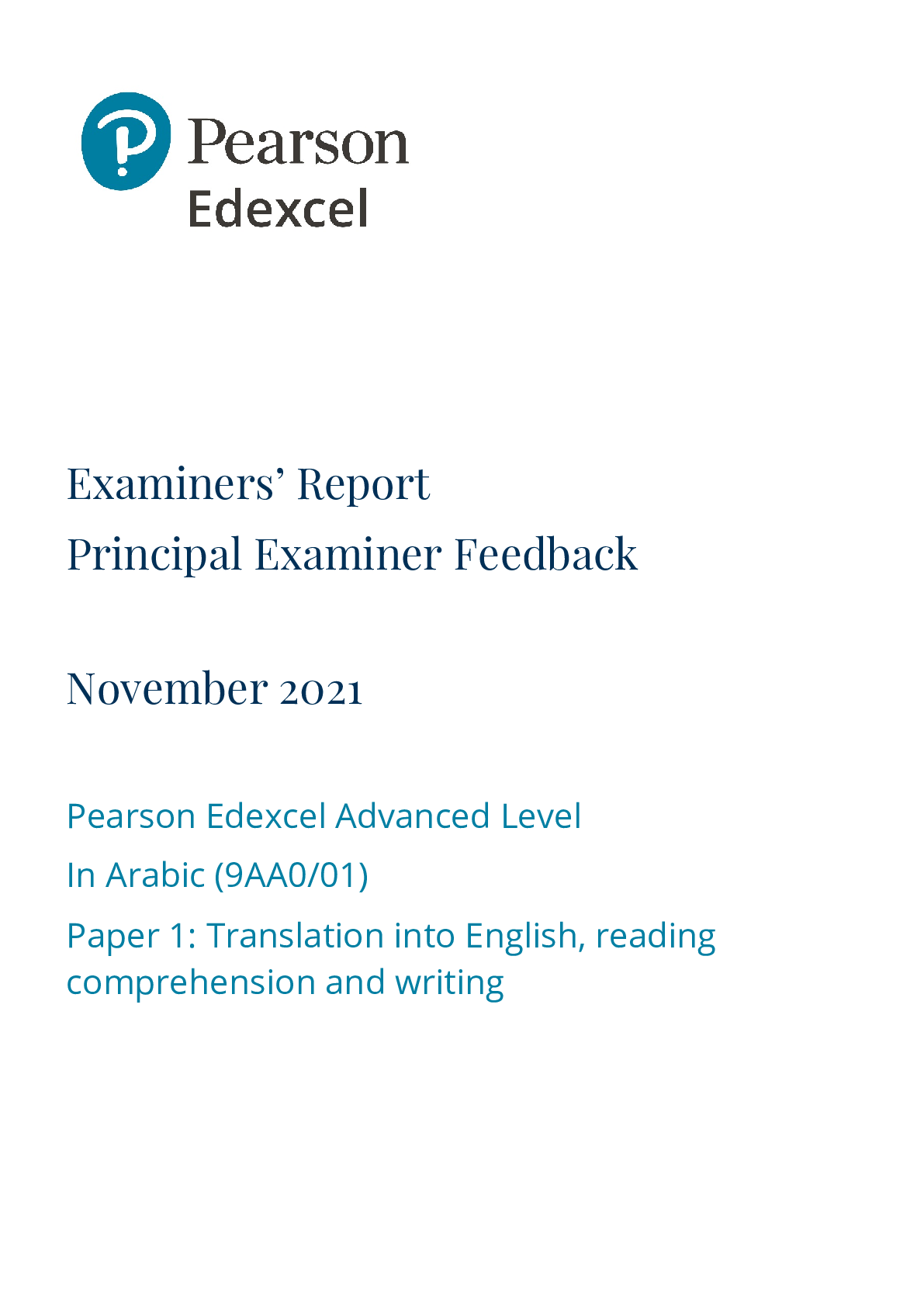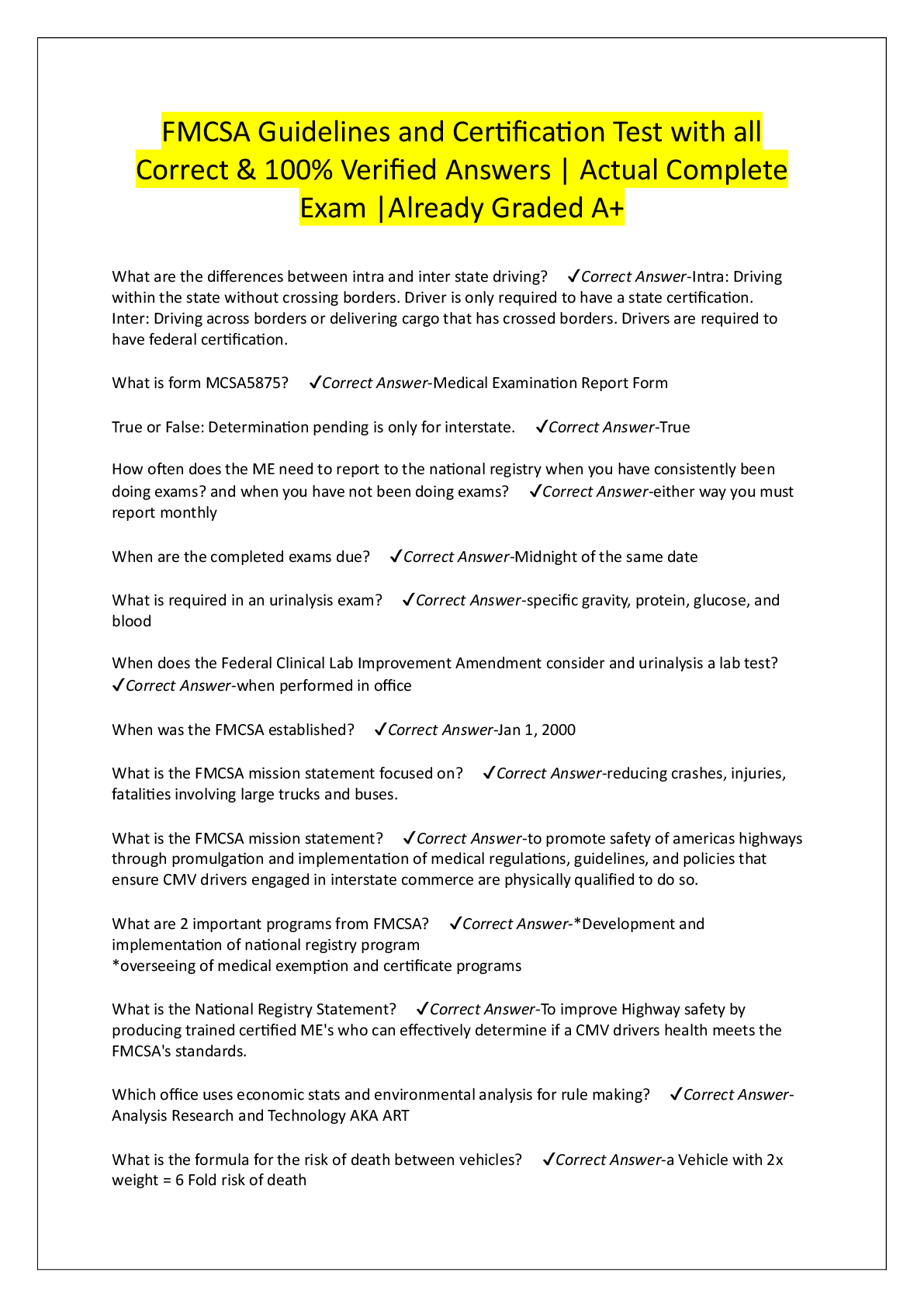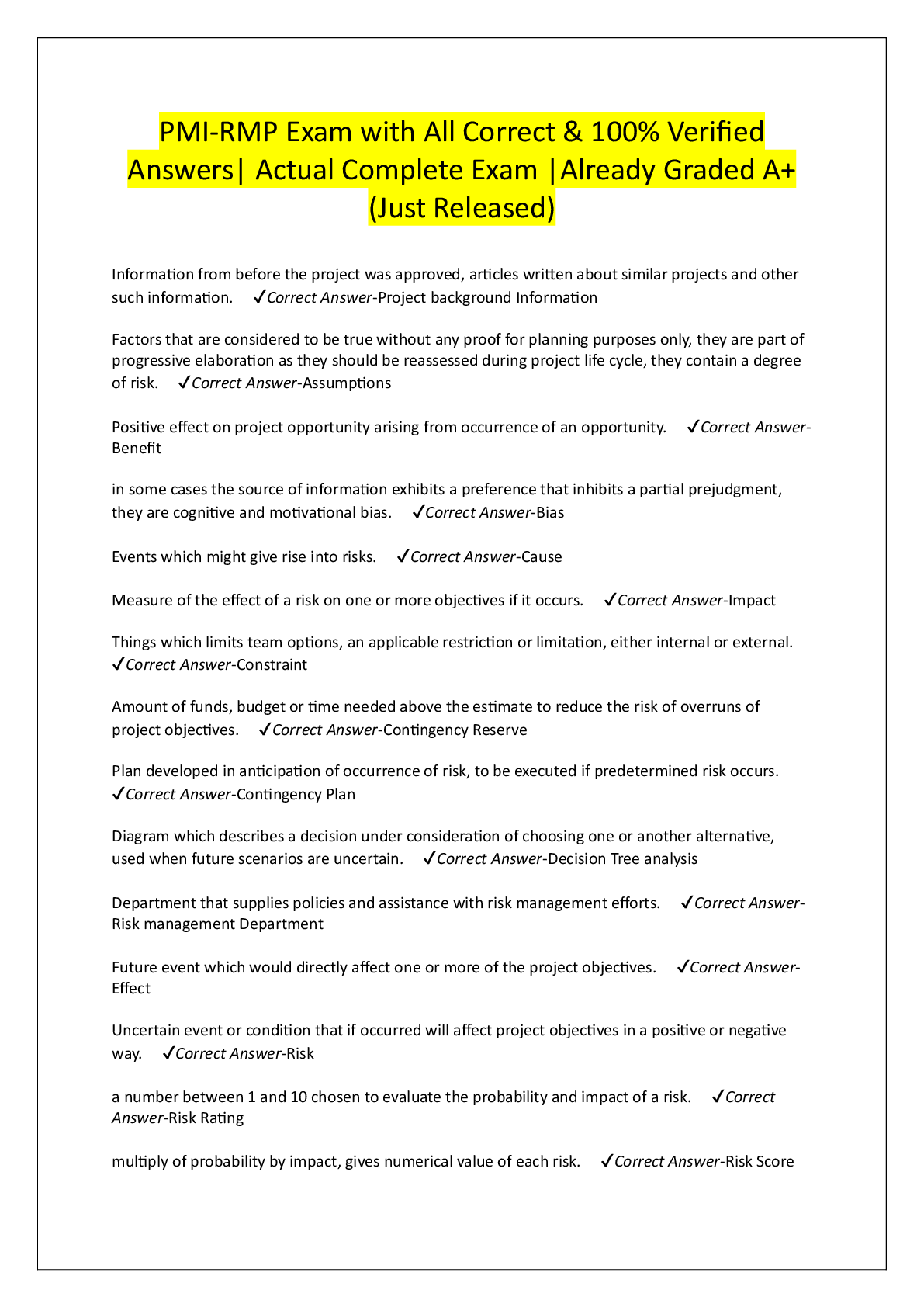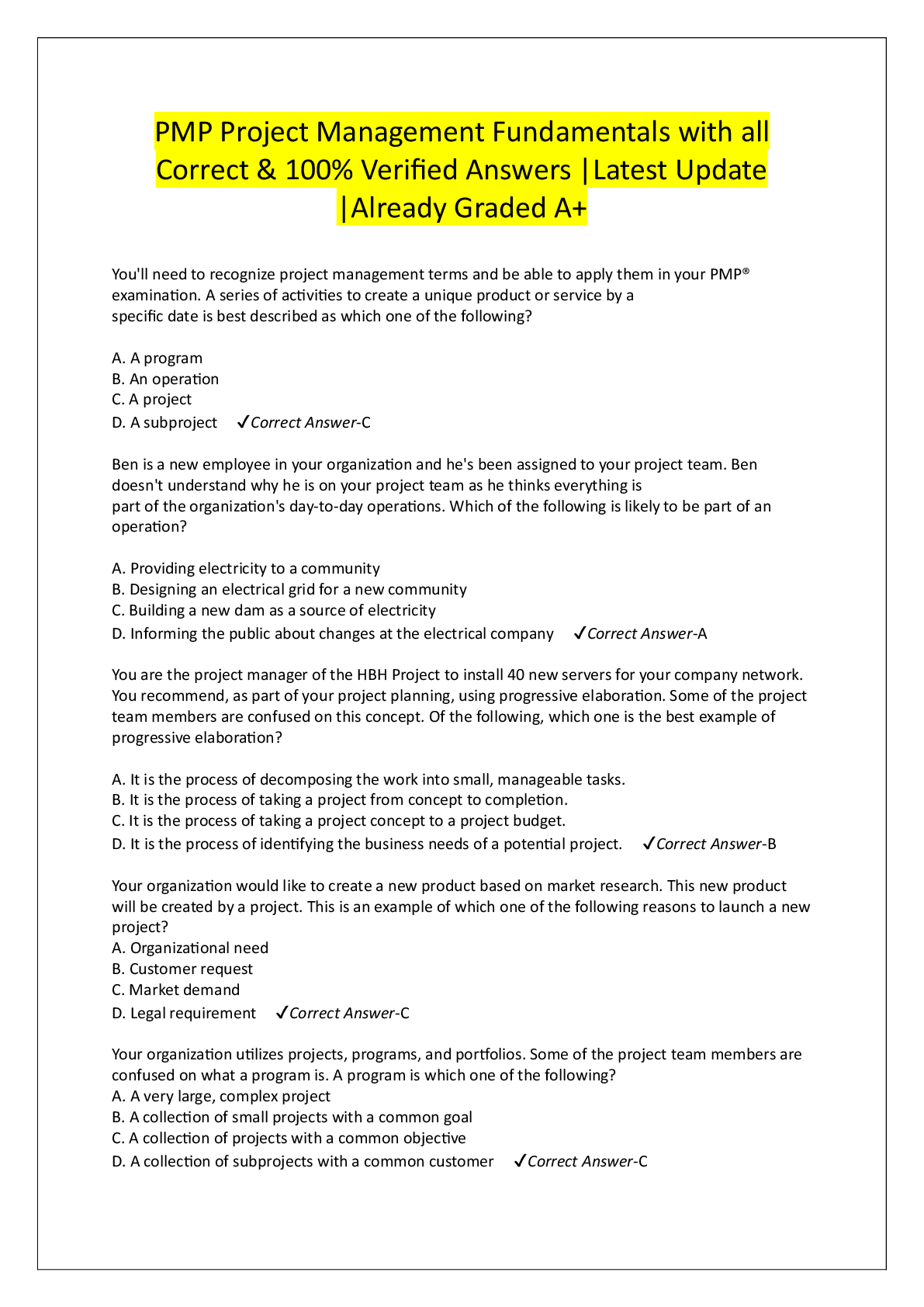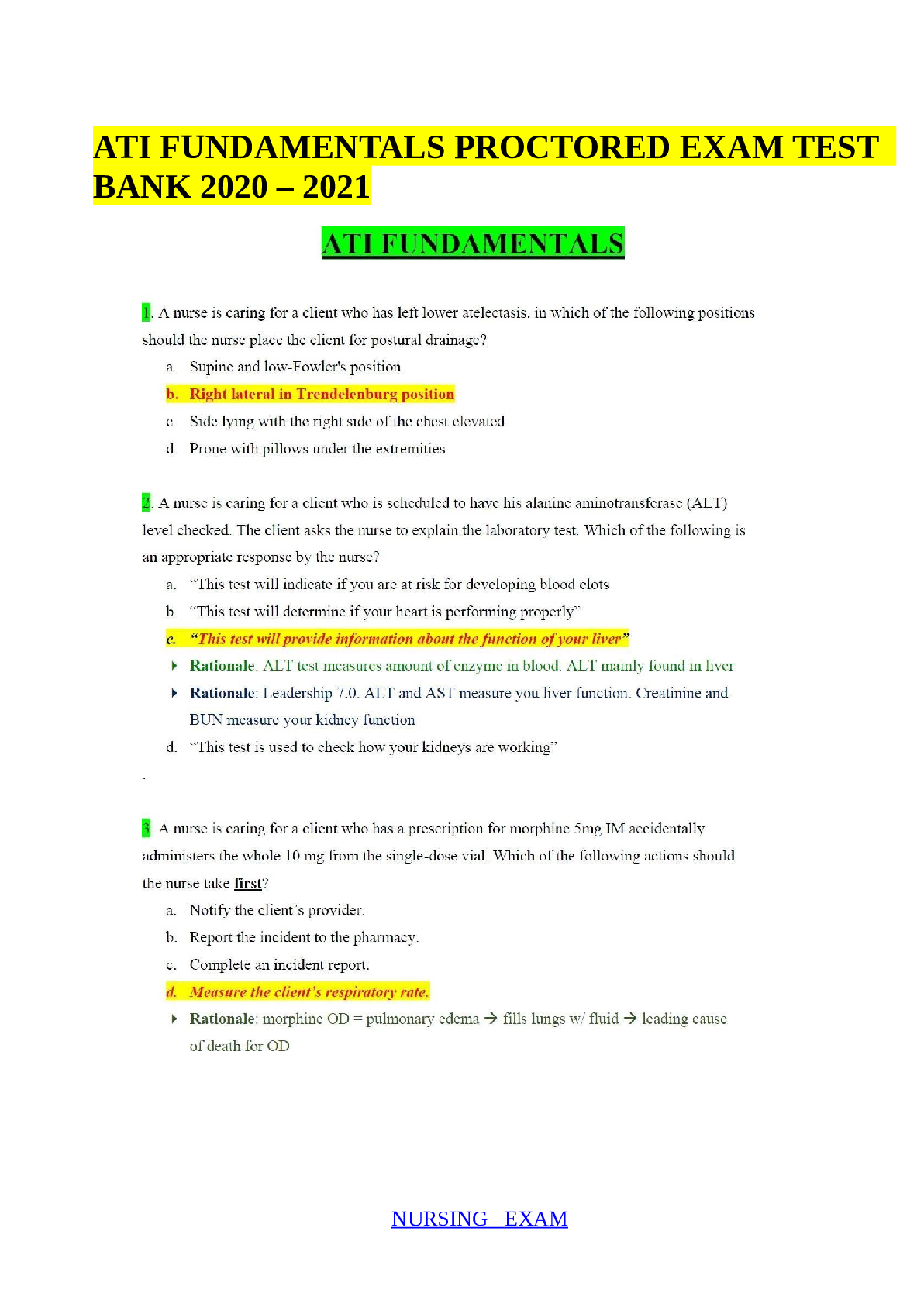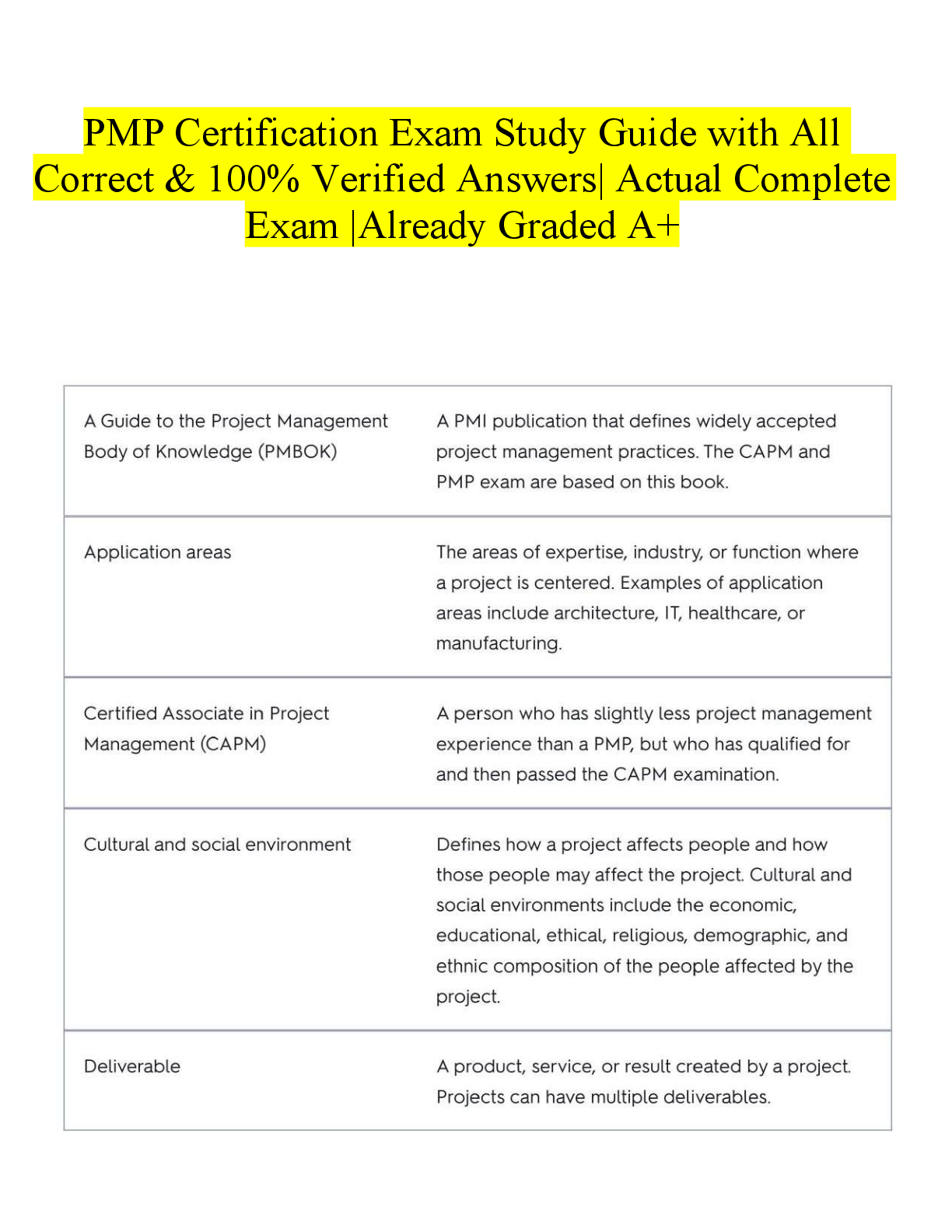SCIENCE 101 > EXAM > SCI 228 Week 8 Final Exam (Questions and Answers) (All)
SCI 228 Week 8 Final Exam (Questions and Answers)
Document Content and Description Below
SCI 228 Week 8 Final Exam (Questions and Answers) Question 1 5 / 5 pts (CO 1) Which government agency regulates organic farming standards in the United States? Food and Drug Administration ... United States Department of Agriculture Environmental Protection Agency Centers for Disease Control Chapter 18 Question 2 5 / 5 pts (CO 1) The second step of the scientific method is observation and description of a phenomenon. testing a research question or hypothesis. generating a hypothesis. collecting data. Chapter 1 Question 3 5 / 5 pts (CO 1) Which of the following best describes the Delaney Clause? Government action that prevents the intentional addition of compounds that have been shown to cause cancer in animals or humans Government recommendation that all predatory fish be tested for mercury before being sold to the consumer List of food additives generally regarded as safe; established in 1958 by the U.S. Congress Pending legislation to ban irradiation as a method of food preservation Chapter 18 Question 4 5 / 5 pts (CO 1) The Nutrition facts panel on a box of crackers indicates that one serving provides 140 calories, with 55 calories coming from fat. Calculate the percentage of calories from fat in this product. 39% 55% 85% Need more information to calculate. Chapter 2 Question 5 5 / 5 pts (CO 1) Your grandmother has recently been diagnosed with Type II diabetes. Which of the following professionals is most likely to be qualified to offer your grandmother assistance in planning her diabetic diet? Registered dietitian (RD) PhD in nutrition Medical doctor (MD) Nutritionist Chapter 1 Question 6 5 / 5 pts (CO 1) The standard used to estimate the daily nutrient needs of half of all healthy individuals is EAR. AI. RDA. UL. Chapter 2 Question 7 5 / 5 pts (CO 2) The type of eating disorder characterized by episodes of denial of hunger is anorexia nervosa. bulimia nervosa. disordered eating. binge eating disorder. Chapter 15 IncorrectQuestion 8 0 / 5 pts (CO 2) Which of the following symptoms is characteristic of bulimia nervosa? Episodes of extreme overeating (Correct) Self-starvation Both episodes of extreme overeating and self-starvation None of these items shown. Chapter 15 Question 9 5 / 5 pts (CO 2) Which of the following increases one's risk of developing an eating disorder? Large family size Holding the first order of birth Having a sibling with an eating disorder Large family size, holding the first order of birth, and having a sibling with an eating disorder Chapter 15 Question 10 5 / 5 pts (CO 2) Obsessive-compulsive, perfectionism, socially inhibited, compliant, and emotionally restrained describe personality traits of anorexia nervosa. bulimia nervosa. binge eating disorder. obesity. Chapter 15 Question 11 5 / 5 pts (CO 2) Without sufficient _____, the colon gets too little exercise and becomes weak. calories protein fiber water Chapter 4 Question 12 5 / 5 pts (CO 2) Which of the following are substances in plant foods that are not absorbed by the body? Starch Disaccharides Dietary fiber Simple sugars Chapter 4 Question 13 5 / 5 pts (CO 2) A diet low in fiber is associated with an increased risk of developing kidney stones. dental caries. diabetes. diverticulosis. Chapter 4 IncorrectQuestion 14 0 / 5 pts (CO 2) Which of the following is a micronutrient? Carbohydrates Vitamins (Correct) Lipids Alcohol Chapter 1 Question 15 5 / 5 pts (CO 3) If a person is suffering from GERD, the _____ is malfunctioning. gallbladder pancreas epiglottis gastro-esophageal sphincter Chapter 3 Question 16 5 / 5 pts (CO 3) Proteins that act to speed up body processes, but are not changed in the process, are called hormones. peptides. enzymes. chymes. Chapter 3 Question 17 5 / 5 pts (CO 3) Barbara has just been diagnosed with celiac disease. Which of the following foods would be most dangerous for her to consume? Cornflakes Rice cakes Potatoes Whole-wheat bread Chapter 3 Question 18 5 / 5 pts (CO 3) Not only is HCL produced in the stomach to help with enzyme transformation, another function of the stomach is to neutralize stomach acid. activate pepsinogen to form pepsin. protect stomach cells from auto digestion. emulsify fats. Chapter 6 IncorrectQuestion 19 0 / 5 pts (CO 4) Which of the following will likely result if the concentration of electrolytes inside of a cell is higher than in the extracellular environment? The cell will burst. (Correct) The cell will shrink and dry up. The cell will undergo mitosis and divide. The cell will be unaffected. Chapter 8 Question 20 5 / 5 pts (CO 4) Water is known as the universal solvent. Water helps to regulate body temperature. Water helps to maintain blood volume. Water works as an excellent cleansing agent to flush toxins out of the body. Most solutes (particles) will dissolve in water. Chapter 8 Question 21 5 / 5 pts (CO 4) Extracellular fluid consists of tissue fluid (interstitial fluid). plasma. fluid between the body cells. both tissue fluid (interstitial fluid) and plasma. Chapter 8 Question 22 5 / 5 pts (CO 4) Which of the following terms is synonymous with the word malignant? Tumor Benign Cancer Undifferentiated Chapter 8 Question 23 5 / 5 pts (CO 4) Which organ is primarily responsible for maintaining fluid balance? Small intestine Kidneys Liver Pancreas Chapter 8 IncorrectQuestion 24 0 / 5 pts (CO 4) Which of the following is a disaccharide? Sucrose Fructose Galactose Glucose Chapter 4 Question 25 5 / 5 pts (CO 4) When fructose and glucose are bonded together, they form table sugar. malt sugar. milk sugar. fruit sugar. Chapter 4 Question 26 5 / 5 pts (CO 4) Which of the following carbohydrates is the end product of photosynthesis? Glycogen Galactose Lactose Glucose Chapter 4 Question 27 5 / 5 pts (CO 4) In the body, the major storage sites for glycogen are the muscles and liver. kidney and muscles. liver and kidney. liver and pancreas. Chapter 4 Question 28 5 / 5 pts (CO 5) The vast majority of fat digestion and absorption occurs in the pancreas. liver. small intestine. gall bladder. Chapter 5 IncorrectQuestion 29 0 / 5 pts (CO 5) A fatty acid that contains a chain of 10 carbons and two double bonds is termed a saturated, medium-chain fatty acid. polyunsaturated, medium-chain fatty acid. (Correct) monounsaturated, medium-chain fatty acid. monounsaturated, long-chain fatty acid. Chapter 6 Question 30 5 / 5 pts (CO 5) Triglycerides are classified by the length of the fatty acids. the saturation of the fatty acids. the shape of the fatty acids. the length of the fatty acids, the saturation of the fatty acids, and the shape of the fatty acids. Chapter 6 Question 31 5 / 5 pts (CO 5) Which of the following fatty acids is generally solid at room temperature? Trans Saturated Monounsaturated Polyunsaturated Chapter 6 Question 32 5 / 5 pts (CO 5) The process of adding hydrogen to an unsaturated fatty acid and creating a more solid fat is called emulsification. pressurization. hydrogenation. deamination. Chapter 5 Question 33 5 / 5 pts (CO 6) Which of the following supplements would you recommend that a vegan add to his or her diet? Protein Fiber Vitamin B12 Vitamin C Chapter 6 Question 34 5 / 5 pts (CO 6) Per gram, which of the following foods would contain the highest protein content? Cooked carrots Chicken Skim milk Whole-wheat bread Chapter 6 Question 35 5 / 5 pts (CO 6) Well planned vegetarian diets can reduce the risk of all of the following chronic diseases except obesity. heart disease. anemia. cancer. Chapter 6 Question 36 5 / 5 pts (CO 6) Which of the following is a genetic disorder resulting in debilitating protein abnormalities? Cystic fibrosis Mad cow disease Marasmus Kwashiorkor Chapter 6 Question 37 5 / 5 pts (CO 6) Vegetarian diets are associated with increased consumption of carcinogens. antioxidants. prions. Vitamins B12 and D. Chapter 6 Question 38 5 / 5 pts (CO 6) Of the 20 amino acids relevant to the human body, how many are considered essential? All 20 are essential. 11 9 10 Chapter 6 Question 39 5 / 5 pts (CO 6) During the process of protein synthesis, _____ is the step in which messenger RNA is decoded into an amino acid sequence at the cell's ribosome. transcription translation deamination denaturation Chapter 6 Question 40 5 / 5 pts (CO 7) Which of the following organs is responsible for the synthesis of Vitamin D? Skin Pancreas Gallbladder All of these Chapter 9 Question 41 5 / 5 pts (CO 7) Which nutrient serves as a cofactor to various enzymes involved in the coagulation of blood? Iron Vitamin K Vitamin D Both iron and Vitamin K Chapter 9 Question 42 5 / 5 pts (CO 7) Vitamin K's primary role in the body is muscle contraction. enzyme action. nerve transmission. blood clotting. Chapters 9 and 10 Question 43 5 / 5 pts (CO 7) Due to the fact that newborns do not have enough bacteria in their small intestine to make _____, they are given an injection of this nutrient. Vitamin K iron calcium folate Chapters 9 and 10 Question 44 5 / 5 pts (CO 7) Soft drinks are high in phosphorus. calcium. potassium. selenium. Chapter 9 IncorrectQuestion 45 0 / 5 pts (CO 7) Green leafy vegetables are good sources of magnesium. Vitamin K. B vitamins. magnesium, Vitamin K, and B vitamins. (Correct Answer) Chapters 9 and 10 Question 46 5 / 5 pts (CO 7) During the second trimester, women are advised to gain no more than 3 to 5 pounds. 1 pound per week. 10–15 pounds 15–20 pounds Chapter 19 Question 47 5 / 5 pts (CO 7) Recommended weight gain during pregnancy is based on the mother's weight at the end of the first trimester. size of the fetus at 3 months' gestation. mother's prepregnancy body mass index. mother's age. Chapter 19 Question 48 5 / 5 pts (CO 7) Due to the fact that the demand for red blood cells increases during pregnancy, what nutrient is needed regularly? Calcium Iron Folate Calcium, iron, and folate. Chapter 19 Question 49 5 / 5 pts (CO 7) Which of the following fatty acids is critical to fetal brain and eye development? Trans fatty acid Stearic acid Omega 3 fatty acid Palmitic acid Chapters 19 and 20 Question 50 5 / 5 pts (CO 7) All of the following are physiological changes that typically occur with aging except decreased lean body mass. decreased bone density. decreased fat mass. decreased immune function. Chapter 20 Quiz Score: 220 out of 250 [Show More]
Last updated: 3 years ago
Preview 1 out of 14 pages

Buy this document to get the full access instantly
Instant Download Access after purchase
Buy NowInstant download
We Accept:

Also available in bundle (1)
Click Below to Access Bundle(s)

SCI 228 Final Exam (03 Versions) Questions and Answers
SCI 228 Final Exam (03 Versions) Questions and Answers
By YourTutor 4 years ago
$40.5
3
Reviews( 0 )
$17.00
Can't find what you want? Try our AI powered Search
Document information
Connected school, study & course
About the document
Uploaded On
Feb 22, 2021
Number of pages
14
Written in
All
Additional information
This document has been written for:
Uploaded
Feb 22, 2021
Downloads
0
Views
121












